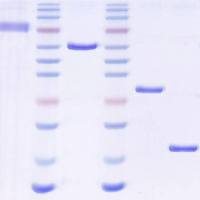A technique is presented for high-resolution postembedding immunolocalization of one or two (or several) antigens in the same ultrathin cryosection using primary monoclonal antibodies from the same species. The optimized three-layer indirect immunogold-labeled cryosection electron microscopy described is recommended for studies of virus-cell interactions, because: (1 ) it is a simple and reproducible method; (2 ) colloidal gold markers are electron-dense, stable, and easy to recognize; (3 ) the membraneous ultrastructure and immunolabeling are well preserved; (4 ) immunolabeling is less in the two-layer method; (5 ) silver-enhanced gold particles vary in size and shape; (6 ) it is possible to demonstrate herpes simplex virus type 1 glycoproteins gC-1 and gD-1 in the nuclear membranes and gC-1- and gD-1-labeled viral particles in the perinuclear space and to observe virions in the endoplasmic reticulum and Golgi area. The use of buffered 3% paraformaldehyde plus 2% glutaraldehyde for 2 h at room temperature effectively destroys free anti-IgG binding sites on the secondary antibodies in double-labeling immunogold cryosection electron microscopy and is recommended because: (1) inactivation is obtained through buffered primary fixative; (2 ) the method is simple and reproducible; (3 ) cross-labeling is effectively avoided; (4 ) silver-intensification, high temperature, and methyl cellulose cover of ultrathin cryosections are avoided between the staining sequences; and (5 ) ultrastructure and antigenicity are well preserved.






